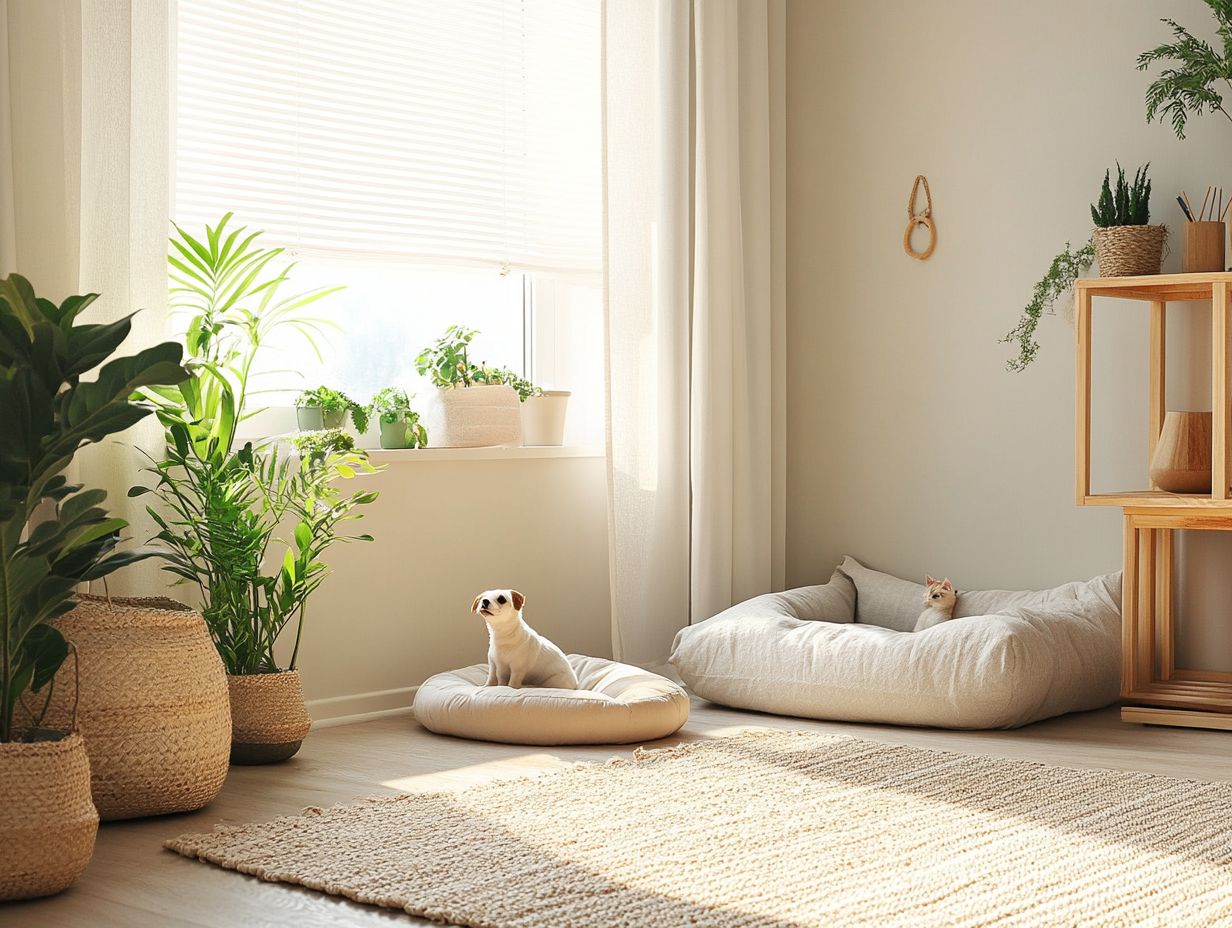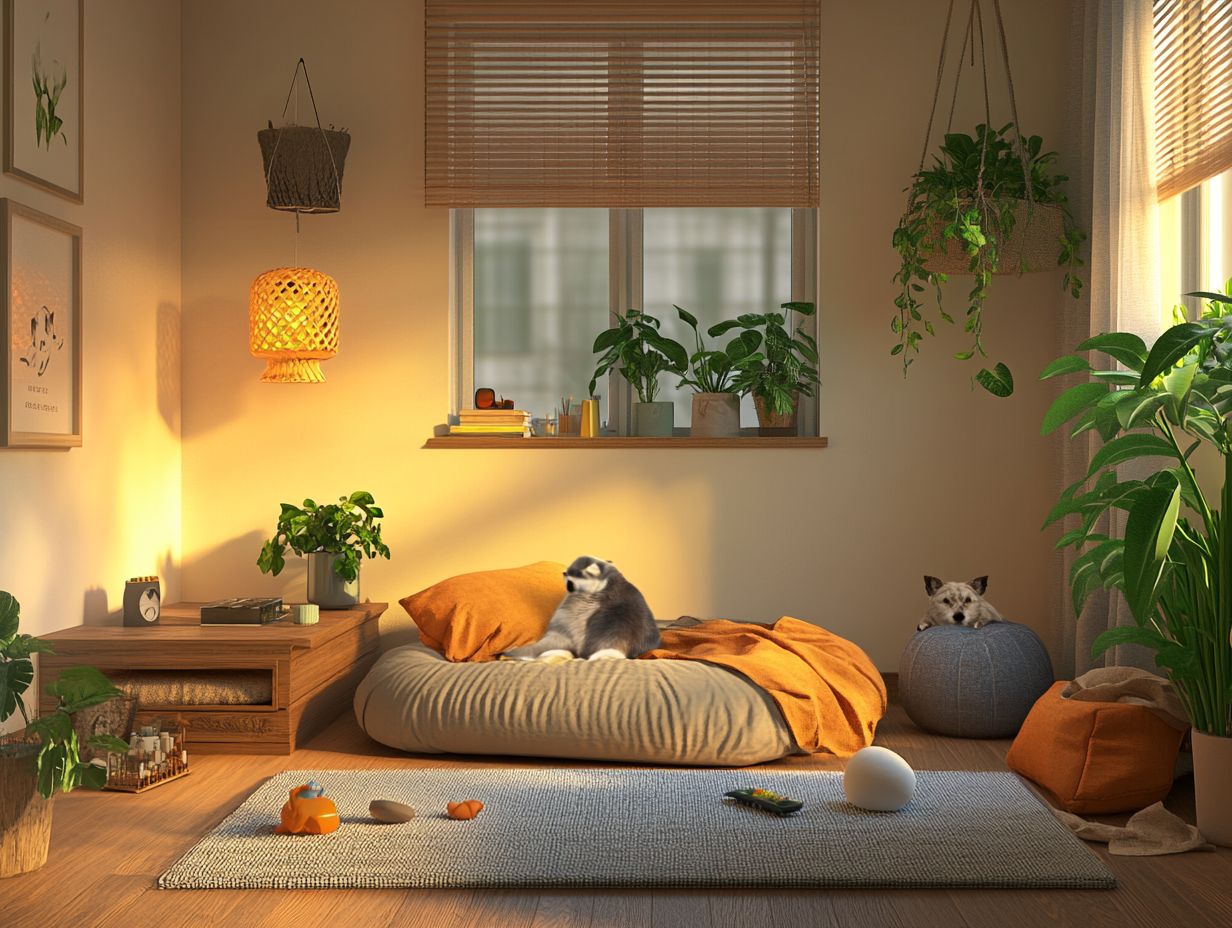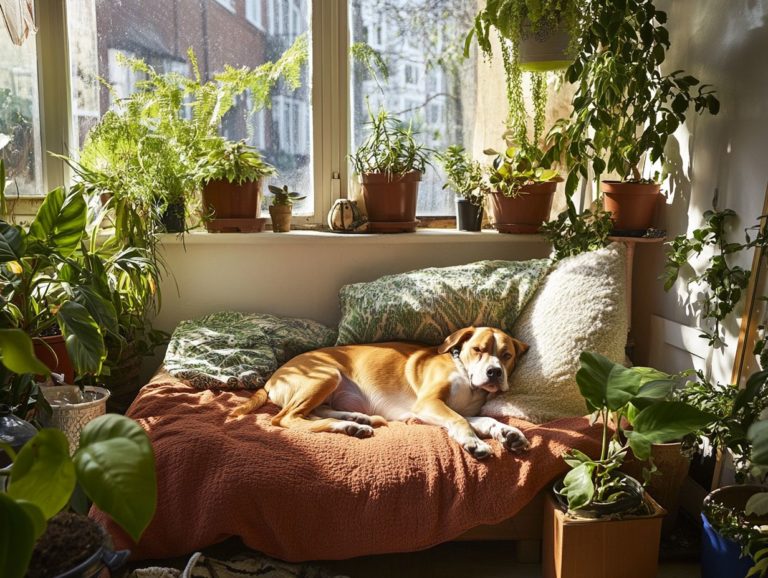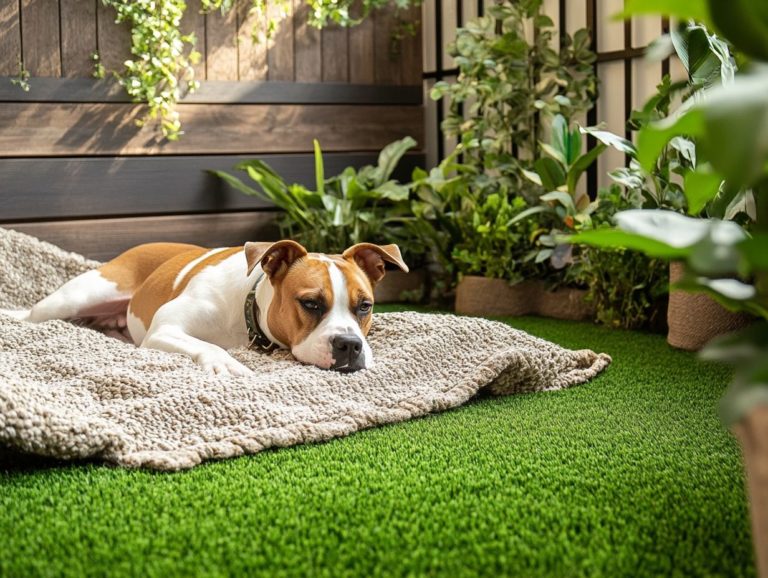Creating a Home Environment for Anxious Pets
Pet anxiety is an increasingly pressing concern for pet owners like you, impacting the well-being of your beloved furry companions.
Recognizing the causes and symptoms is the crucial first step toward ensuring they feel secure in their environment. This article delves into effective strategies for cultivating a serene home atmosphere, minimizing stressors, and establishing a comforting routine that works for both you and your pet.
It will also cover natural remedies and provide guidance on when to seek professional assistance for more serious cases. By prioritizing your pet s mental health, you can create a safe, nurturing space where they can truly thrive.
Contents
- Key Takeaways:
- Understanding Pet Anxiety
- Creating a Calm and Safe Home Environment
- Using Natural Remedies for Pet Anxiety
- Professional Help for Anxious Pets
- Preventing and Managing Anxiety in the Long Term
- Frequently Asked Questions
- What are some signs that my pet may be experiencing anxiety in our home?
- How can I create a calm and safe environment for my anxious pet?
- What can I do to help my pet feel more secure at home?
- Should I consider using medication to help my pet with their anxiety?
- Are there any natural remedies that can help ease my pet’s anxiety?
- Can my pet overcome anxiety in our home environment?
Key Takeaways:

- Understanding the causes and symptoms of pet anxiety is crucial for creating a calm and safe home environment.
- Reducing triggers and stressors, and establishing a routine, are effective ways to alleviate anxiety in pets.
- Utilizing natural remedies and seeking professional help when necessary can greatly improve the well-being of anxious pets.
Understanding Pet Anxiety
Understanding pet anxiety is essential for you as a pet owner. It greatly affects your dog s emotional health and overall well-being.
Anxiety in pets can reveal itself through various behaviors, such as excessive barking, destructive tendencies, and avoidance during stressful situations. Recognizing these signs of anxiety is your first step toward fostering a nurturing environment that enhances mental health and minimizes anxiety triggers.
By doing so, you ensure that your dog feels safe and secure in the comfort of their home and daily routines.
Causes and Symptoms
The causes and symptoms of pet anxiety can vary significantly, influenced by factors like environmental stressors think thunderstorms and social triggers, such as separation from you.
Your home is the key to your pet’s happiness. Loud noises, unfamiliar guests, or even shifts in routine can heighten their feelings of insecurity. Past traumas, including abuse or neglect, can leave lasting impressions, resulting in heightened alertness or fear in your furry companion. For those looking to ease these challenges, learning how to help an anxious pet adjust to new environments can be beneficial. Pets that miss early socialization may struggle to adapt to new experiences, leading to increased apprehension.
You might observe symptoms of anxiety manifesting in various ways. For example, if your pet is barking excessively, it could signal distress, while pacing may indicate restlessness. Destructive behaviors, like chewing on furniture or digging, often reveal a pet’s desperate need for relief from their internal chaos.
Creating a Calm and Safe Home Environment
Creating a calm and safe home environment for your pet is crucial in alleviating anxiety and fostering a sense of security. For effective strategies, consider how to create a calm environment for anxious pets. A thoughtfully designed space should feature safe zones where your dog can retreat during stressful moments, along with calming strategies to help mitigate anxiety triggers.
Consider integrating comfortable elements such as soothing beds and gentle music, while also establishing daily routines and providing the affectionate care that addresses your dog’s unique emotional needs.
Reducing Triggers and Stressors
Reducing triggers and stressors is crucial for effectively managing pet anxiety, particularly for those fearful dogs that might react adversely to sudden noises or changes in their surroundings.
The first step in creating a serene environment is recognizing the signs of anxiety in your pet. Pay close attention to your furry friend during thunderstorms or fireworks—those notorious anxiety-inducing events. Consider creating a zen corner for your anxious pet to help them feel more secure.
To mitigate these situations, it s essential to provide a safe space where your dog can retreat when feeling overwhelmed. Incorporating calming techniques can truly make a difference. Many pet owners find that calming supplements work wonders, while interactive chew toys can keep your dog occupied and distracted during stressful moments.
Establishing a routine and using positive reinforcement, which means rewarding good behavior, can help your beloved pet navigate these tough situations.
Start creating a calm space for your pet today, and watch them thrive!
Establishing a Routine

A consistent daily routine offers great benefits for anxious pets. It provides them with predictability and security.
This structure minimizes stress and enhances their overall well-being.
Key components of such a routine include:
- Regular exercise tailored to your dog s unique needs, helping to burn off excess energy while stimulating their minds.
- Scheduled feeding times that create a sense of order, allowing your pet to feel more secure about when and what they will eat.
- Designated play periods that provide essential interaction, fostering strong bonds and allowing dogs to express their natural behaviors.
Spending quality time together reinforces confidence, alleviates anxiety, and deepens the trust between you and your pet.
Using Natural Remedies for Pet Anxiety
Utilizing natural remedies for pet anxiety offers a gentle yet effective pathway to enhance relaxation and emotional well-being in dogs. Consider remedies such as calming drops, soothing sounds, and aromatherapy, a method using scents to promote relaxation, infused with comforting scents like lavender and chamomile.
These approaches can significantly diminish anxiety levels and create an anxiety-free pet environment for your fearful furry companions.
Benefits and Effectiveness
Understanding the benefits and effectiveness of natural remedies can enable you as a pet owner to make informed decisions about managing your dog’s anxiety. These holistic approaches complement traditional training methods, promoting a more balanced lifestyle for your furry friend.
For instance, incorporating herbal supplements like chamomile or valerian root can soothe anxiety in high-strung breeds. Techniques such as aromatherapy with lavender oil have also been shown to create a calming atmosphere.
Pet owners who have adopted these strategies frequently report noticeable improvements in their dog s behavior, including reduced barking and more relaxed interactions during stressful events like fireworks or vet visits.
By blending these natural remedies with conventional training, you can significantly enhance your pet’s overall quality of life, deepening the bond between you and your beloved companion.
Professional Help for Anxious Pets
When managing severe anxiety in pets, seeking professional help is essential. This step addresses underlying behavioral issues and enhances their overall quality of life.
Work with trainers and vets for tailored treatment options that suit your anxious dog. This proactive approach ensures that your furry companion receives the attention and support necessary for their well-being.
When to Seek Assistance
Knowing when to get help for your pet s anxiety can transform their well-being. As a pet owner, it s not always easy to pinpoint those critical moments when expert guidance is needed.
Look for signs like persistent barking, destructive behaviors, or excessive fears that linger despite your best efforts at home. These may signal that it s time to call in the professionals.
Without proper strategies, these behavior patterns can escalate, and that s where dog training becomes essential. Experienced trainers can arm you with effective techniques, particularly emphasizing positive reinforcement.
By using these methods, professionals not only help to modify negative behaviors but also cultivate a trusting relationship between you and your pet, creating a happier, healthier environment for both of you.
Types of Treatment Options

There are various treatment options available to help you manage anxiety in your pets. Each option is designed to address specific behavioral issues and emotional needs.
Veterinarians and animal behaviorists often take a comprehensive approach. They tailor their strategies to fit your pet s unique temperament and triggers.
Behavioral training may involve exposure training, allowing your pets to gradually acclimate to stressful situations. You might find calming strategies helpful, such as creating a safe space or incorporating soothing music for immediate relief.
Natural remedies, including herbal supplements and aromatherapy (using pleasant scents to promote relaxation), are also popular. These can work effectively alongside other methods. By carefully evaluating your pet s individual circumstances, professionals can craft a customized plan that fosters confidence and enhances overall well-being.
Preventing and Managing Anxiety in the Long Term
Preventing and managing anxiety in the long term requires a proactive approach that cultivates a nurturing environment. Understanding the importance of calm spaces for anxious pets can greatly encourage healthy daily habits for your pets.
By creating a supportive atmosphere and implementing routine practices, you can significantly enhance their well-being and resilience against anxiety.
Continuing a Calm and Safe Environment
Maintaining a calm and safe environment is crucial for promoting stress relief and overall well-being for your pet. For specific strategies, check out how to set up a calm space for my anxious pet.
You can achieve this by integrating specific practices into their daily routine. For instance, arranging furniture for anxious pets by providing a calming bed in a quiet corner creates a cozy sanctuary where your pet feels secure.
Incorporating soothing sounds, like gentle music or nature sounds, helps to drown out abrupt noises that may induce anxiety.
Regularly monitoring your pet’s behavior and adjusting their surroundings ensures their comfort remains a priority. For example, creating a routine for anxious pets by dimming the lights or reducing clutter can significantly enhance their sense of security and tranquility.
Maintaining Good Mental Health for Pets
Maintaining your pet’s mental health involves regular exercise, quality time spent together, and creating a nurturing environment that meets their emotional needs.
This holistic approach not only fosters a sense of security and happiness in their daily lives but also strengthens the bond between you and your dog.
Engaging in activities like playtime, training sessions, and leisurely walks can significantly enhance your dog’s overall well-being. By providing interactive toys and opportunities for socialization, you can effectively alleviate boredom and anxiety.
Incorporating these essential elements into your daily routine creates a fulfilling atmosphere where your dog can thrive emotionally. This ultimately leads to a happier and healthier life for both your pet and yourself.
Frequently Asked Questions
What are some signs that my pet may be experiencing anxiety in our home?

Some common signs of anxiety in pets include excessive grooming, hiding, loss of appetite, destructive behavior, and increased vocalization or panting.
How can I create a calm and safe environment for my anxious pet?
Start by designating a quiet and comfortable space for your pet to retreat to when feeling anxious. For detailed guidance, check out how to create a safe space for anxious pets. This could be a crate, a specific room, or a spot with a bed and calming pheromones.
Also, establish a consistent routine and minimize loud noises and sudden changes in the environment.
What can I do to help my pet feel more secure at home?
Providing your pet with plenty of physical and mental stimulation can help them feel more secure and confident in their surroundings. This can include daily play sessions, training exercises, and interactive toys.
Should I consider using medication to help my pet with their anxiety?
If your pet’s anxiety is severe and negatively impacting their daily life, consult with a veterinarian about medication options. However, medication should always be used in combination with behavior modification techniques and should not be seen as a standalone solution.
Are there any natural remedies that can help ease my pet’s anxiety?
Some natural remedies that can help reduce anxiety in pets include CBD oil, calming scents, and herbal supplements. Always consult with a veterinarian before trying new remedies.
Can my pet overcome anxiety in our home environment?
Pets can overcome anxiety at home. Patience and consistency are key.
While it takes time and effort, your pet’s journey to calmness is worth it! Start your pet’s journey to a calmer life today!






